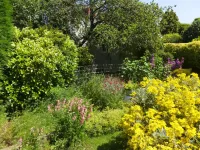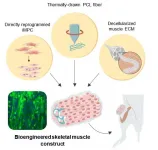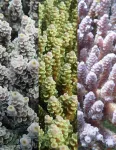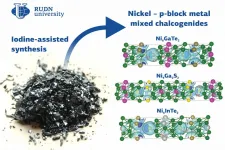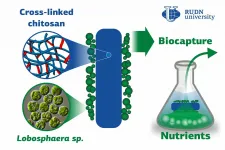(Press-News.org) Home gardens are by far the biggest source of food for pollinating insects, including bees and wasps, in cities and towns, according to new research.
The study, led by the University of Bristol and published today in the Journal of Ecology, measured for the first time how much nectar is produced in urban areas and discovered residential gardens accounted for the vast majority - some 85 per cent on average.
Results showed three gardens generated daily on average around a teaspoon of Nature's ambrosia, the unique sugar-rich liquid found in flowers which pollinators drink for energy. While a teaspoon may not sound much to humans, it's the equivalent to more than a tonne to an adult human and enough to fuel thousands of flying bees. The more bees and fellow pollinators can fly, the greater diversity of flora and fauna will be maintained.
Ecologist Nicholas Tew, lead author of the study, said: "Although the quantity and diversity of nectar has been measured in the countryside, this wasn't the case in urban areas, so we decided to investigate.
"We expected private gardens in towns and cities to be a plentiful source of nectar, but didn't anticipate the scale of production would be to such an overwhelming extent. Our findings highlight the pivotal role they play in supporting pollinators and promoting biodiversity in urban areas across the country."
The research, carried out in partnership with the universities of Edinburgh and Reading and the Royal Horticultural Society, examined the nectar production in four major UK towns and cities: Bristol, Edinburgh, Leeds, and Reading. Nectar production was measured in nearly 200 species of plant by extracting nectar from more than 3,000 individual flowers. The extraction process involves using a fine glass tube. The sugar concentration of the nectar was quantified with a refractometer, a device which measures how much light refracts when passing through a solution.
"We found the nectar supply in urban landscapes is more diverse, in other words comes from more plant species, than in farmland and nature reserves, and this urban nectar supply is critically underpinned by private gardens," said Nicholas Tew, who is studying for a PhD in Ecology.
"Gardens are so important because they produce the most nectar per unit area of land and they cover the largest area of land in the cities we studied."
Nearly a third (29 per cent) of the land in urban areas comprised domestic gardens, which is six times the area of parks, and 40 times the area of allotments.
"The research illustrates the huge role gardeners play in pollinator conservation, as without gardens there would be far less food for pollinators, which include bees, wasps, butterflies, moths, flies, and beetles in towns and cities. It is vital that new housing developments include gardens and also important for gardeners to try to make sure their gardens are as good as possible for pollinators," Nicholas Tew explained.
"Ways to do this include planting nectar-rich flowers, ensuring there is always something in flower from early spring to late autumn, mowing the lawn less often to let dandelions, clovers, daisies and other plant flowers flourish, avoiding spraying pesticides which can harm pollinators, and avoiding covering garden in paving, decking or artificial turf."
Dr Stephanie Bird, an entomologist at the Royal Horticultural Society, which helped fund the research, said: "This research highlights the importance of gardens in supporting our pollinating insects and how gardeners can have a positive impact through their planting decisions. Gardens should not be seen in isolation - instead they are a network of resources offering valuable habitats and provisions when maintained with pollinators in mind."
INFORMATION:
Paper
'Quantifying nectar production by flowering plants in urban and rural landscapes' by N.E.Tew et al in Journal of Ecology
Notes to editors
A range of images, including caption and credit details, can be found here:
https://drive.google.com/drive/folders/1P8BZDDB7Ry1UW5RxASd2KihVypQpMotf?usp=sharing
Nicholas Tew is available for interview. For interview requests and any other related enquiries, please email: Nicholas.tew@bristol.ac.uk and/or Victoria.tagg@bristol.ac.uk
Muscle is the largest organ that accounts for 40% of body mass and plays an essential role in maintaining our lives. Muscle tissue is notable for its unique ability for spontaneous regeneration. However, in serious injuries such as those sustained in car accidents or tumor resection which results in a volumetric muscle loss (VML), the muscle's ability to recover is greatly diminished. Currently, VML treatments comprise surgical interventions with autologous muscle flaps or grafts accompanied by physical therapy. However, surgical procedures often lead to a reduced muscular function, and in some cases result in a complete graft failure. Thus, there is a demand for additional therapeutic options to improve muscle loss recovery.
A promising strategy to improve ...
Coral within the family Acropora are fast growers and thus important for reef growth, island formation, and coastal protection but, due to global environmental pressures, are in decline
A species within this family has three different color morphs - brown, yellow-green, and purple, which appear to respond differently to high temperatures
Researchers looked at the different proteins expressed by the different color morphs, to see whether these were related to their resilience to a changing environment
The green variant was found to maintain high levels of green fluorescent proteins during summer heatwaves and was less likely to bleach than the other two morphs
This suggest that resistance to thermal stress is influenced by a coral's underlying genetics, ...
Periodic pulses of light forming a comb in the frequency domain are
widely used for sensing and ranging. The key to the miniaturisation of
this technology towards chip-integrated solutions is the generation of
dissipative solitons in ring-shaped microresonators. Dissipative solitons
are stable pulses circulating around the circumference of a nonlinear
resonator.
Since their first demonstration, the process of dissipative soliton
formation has been extensively studied and today it is rather
considered as textbook knowledge. Several directions of further
development are ...
A survey by a Boston University researcher of nearly 33,000 college students across the country reveals the prevalence of depression and anxiety in young people continues to increase, now reaching its highest levels, a sign of the mounting stress factors due to the coronavirus pandemic, political unrest, and systemic racism and inequality.
"Half of students in fall 2020 screened positive for depression and/or anxiety," says END ...
Microorganisms possess natural product biosynthetic gene clusters (BGCs) that may harbor unique bioactivities for use in drug development and agricultural applications. However, many uncharacterized microbial BGCs remain inaccessible. Researchers at University of Illinois Urbana-Champaign previously demonstrated a technique using transcription factor decoys to activate large, silent BGCs in bacteria to aid in natural product discovery.
Now, they have developed a direct cloning method that aims to accelerate large-scale discovery of novel natural products. Their findings are reported in the journal Nature Communications.
Named Cas12a assisted precise targeted cloning using in vivo Cre-lox recombination (CAPTURE), ...
DURHAM, N.C. -- Duke researchers have been studying something that happens too slowly for our eyes to see. A team in biologist Philip Benfey's lab wanted to see how plant roots burrow into the soil. So they set up a camera on rice seeds sprouting in clear gel, taking a new picture every 15 minutes for several days after germination.
When they played their footage back at 15 frames per second, compressing 100 hours of growth into less than a minute, they saw that rice roots use a trick to gain their first foothold in the soil: their growing tips make ...
A chemist from RUDN University, working with a group of colleagues, synthesized three new chalcogenides (compounds that contain metals and elements from group 16 of the periodic table). The team suggested an unusual approach to synthesis that was based on iodine. An article about the work was published in the Dalton Transactions journal.
Chalcogens are elements of group 16 of the periodic table that include oxygen, sulfur, selenium, tellurium, polonium, and livermorium--an artificial radioactive element. Chalcogenides are compounds of chalcogens with metals that are used as photosensitive ...
Several University of Illinois Chicago faculty members have addressed the issue of how to ethically conduct research with Black populations.
In their paper "Ethics of Research at the Intersection of COVID-19 and Black Lives Matter: A Call to Action," authors Natasha Crooks, an assistant professor, Phoenix Matthews, a professor, both of the UIC College of Nursing, and Geri Donenberg, director of the Center for Dissemination and Implementation Science at the UIC College of Medicine, highlight the historical issues that impact research involving Black populations. They also provide recommendations for researchers to ethically engage Black populations in research. ...
Biotechnologists from RUDN University in collaboration with Lomonosov MSU and Kurchatov institute made an important contribution to the technology of phosphate and nitrate biocapture from wastewater using Lobosphaera algae fixed on the filters.The biomass obtained in the course of this process can be used as a fertilizer. The results of the study were published in the Journal of Water Process Engineering.
Phosphates and nitrates get to the wastewater together with industrial and household waste, especially detergents. Both substances are parts of phosphorus and nitrogen chemical cycles. However, these cycles are disturbed by human activity, as the growing amounts of phosphates and nitrates cannot be processed by water ecosystems. As a result, these substances turn from useful nutrients ...
New Orleans, LA - A retrospective study conducted by LSU Health New Orleans reports that contrary to previous research, most patients who drop out of peritoneal dialysis may do so for psychosocial reasons. The findings are published in The American Journal of the Medical Sciences, available here. The paper inspired a companion editorial, available here.
The research team evaluated the reasons that 27 of the 83 patients enrolled in the peritoneal dialysis program withdrew between 2016 and 2018. Twenty-four or 86% were African American. They found that psychosocial factors, including mental health illness such as anxiety and depression, loss of support networks, or inability to tolerate ...
